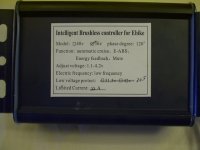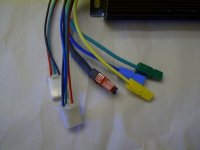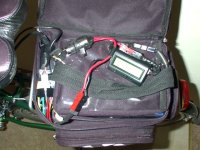Russell
1 MW
I recently purchased a Nine Continent kit with a 36V/22A controller which can handle 48V (63V caps) so I decided to try it on my Raleigh E-bike equipped with a Bafang front motor. The stock controller that came with the Bafang is a little 36V/15A unit with 50V caps which could very well blow up if I would try running it on a 48V battery pack. To my surprise the 9C controller worked perfectly with the Bafang (well at first, but read on); I didn’t have to swap a single wire  I did reterminate the DC input and motor power connectors with Andersons to match my present configuration.
I did reterminate the DC input and motor power connectors with Andersons to match my present configuration.
View attachment 4


View attachment 1

I had the original controller mounted on the handlebars with the Watts-Up meter on top which made it convenient to monitor the battery pack however I'm going to use this bike to test out the 9C motor thus having it in back will make that easier due to the short length of the 9C motor cables.
After lengthening the trigger throttle cable and running it and the Bafang motor cables to the rear of the bike and dressing them with a few tie-wraps I was ready for a test ride. I didn't expect any major difference between the controllers and there really wasn't much. The speed was the same unloaded, a tad over 20 mph, and on level ground with a combined weight of 265 lbs it was ~16.5 mph. It did feel a bit stronger accelerating but when you're only going 0-16 mph it's not a big deal.
All was going well until about 5 miles into the ride when the controller started cutting out. It didn't seem to be hitting a current limit since it would accelerate fine but then it would intermittently just cut out. I would release the throttle to reset and squeeze again and I'd be off. At 8 miles I stopped to check the Watts-Up meter which was in the rear bag. It showed the current had peaked at 24A and the minimum voltage was still over 34V. The LVC of the controller is supposed to be 30.5V so THAT should not be the cause of the controller cutting out. Also while the controller was in the rear bag it was cold out (low 40's) and the controller itself wasn't even warm to the touch. I had already used 2.5Ah in just 8 miles when normally I'd go at least 13 miles on that much juice. Anyway since there was obviously a problem I turned toward home early.
At 15 miles the controller was cutting out with much greater frquency. I stopped again to check the meter and still the Vmin was over 33V. I had also used up 3.9Ah. At 17 miles the the thing was cutting out all of the time unless I used ever so little throttle. I had the wind at my back so it wasn't a biggie riding the bike without power.
When I arrived home I had gone 18.75 miles at an average speed of 15.8 mph or pretty much par for the course. I had used 4.239 Ah, 153 Wh or 8.2 Wh/mile with peak watts of 862. Usually I use about 6.5 Wh/mile and the peak watts is about 550. The lesson here is that a higher current limit isn't always necessarily a good thing. I wasn't traveling any faster it's just when accelerating the controller will often max out and in this case that maximum is 60% higher than before. If you want to ride as economically as possible the better choice is the controller with the lower current limit. I didn't do any testing on hills for this first ride and with the controller cutting out it wouldn't be valid anyway so I can't say if climbing was enhanced.
I don't know for sure what was causing the controller to cut out but it appears to me that the LVC might be quite a bit higher than the 30.5V written on the controller. Since the original 31.5 V number is crossed out I wonder if it was modified and they messed it up :?
I put the bike on a stand and used a rubber band to hold the throttle wide open. Even though the pack was nearly depleted the no-load current was insufficient to cause any sag in the battery voltage which was now at 36.1V. With the motor spinning I wiggled every connection with no problem seen.
I left the motor running...and running...and it's still running now.
-R
View attachment 4


View attachment 1

I had the original controller mounted on the handlebars with the Watts-Up meter on top which made it convenient to monitor the battery pack however I'm going to use this bike to test out the 9C motor thus having it in back will make that easier due to the short length of the 9C motor cables.
After lengthening the trigger throttle cable and running it and the Bafang motor cables to the rear of the bike and dressing them with a few tie-wraps I was ready for a test ride. I didn't expect any major difference between the controllers and there really wasn't much. The speed was the same unloaded, a tad over 20 mph, and on level ground with a combined weight of 265 lbs it was ~16.5 mph. It did feel a bit stronger accelerating but when you're only going 0-16 mph it's not a big deal.
All was going well until about 5 miles into the ride when the controller started cutting out. It didn't seem to be hitting a current limit since it would accelerate fine but then it would intermittently just cut out. I would release the throttle to reset and squeeze again and I'd be off. At 8 miles I stopped to check the Watts-Up meter which was in the rear bag. It showed the current had peaked at 24A and the minimum voltage was still over 34V. The LVC of the controller is supposed to be 30.5V so THAT should not be the cause of the controller cutting out. Also while the controller was in the rear bag it was cold out (low 40's) and the controller itself wasn't even warm to the touch. I had already used 2.5Ah in just 8 miles when normally I'd go at least 13 miles on that much juice. Anyway since there was obviously a problem I turned toward home early.
At 15 miles the controller was cutting out with much greater frquency. I stopped again to check the meter and still the Vmin was over 33V. I had also used up 3.9Ah. At 17 miles the the thing was cutting out all of the time unless I used ever so little throttle. I had the wind at my back so it wasn't a biggie riding the bike without power.
When I arrived home I had gone 18.75 miles at an average speed of 15.8 mph or pretty much par for the course. I had used 4.239 Ah, 153 Wh or 8.2 Wh/mile with peak watts of 862. Usually I use about 6.5 Wh/mile and the peak watts is about 550. The lesson here is that a higher current limit isn't always necessarily a good thing. I wasn't traveling any faster it's just when accelerating the controller will often max out and in this case that maximum is 60% higher than before. If you want to ride as economically as possible the better choice is the controller with the lower current limit. I didn't do any testing on hills for this first ride and with the controller cutting out it wouldn't be valid anyway so I can't say if climbing was enhanced.
I don't know for sure what was causing the controller to cut out but it appears to me that the LVC might be quite a bit higher than the 30.5V written on the controller. Since the original 31.5 V number is crossed out I wonder if it was modified and they messed it up :?
I put the bike on a stand and used a rubber band to hold the throttle wide open. Even though the pack was nearly depleted the no-load current was insufficient to cause any sag in the battery voltage which was now at 36.1V. With the motor spinning I wiggled every connection with no problem seen.
I left the motor running...and running...and it's still running now.
-R

